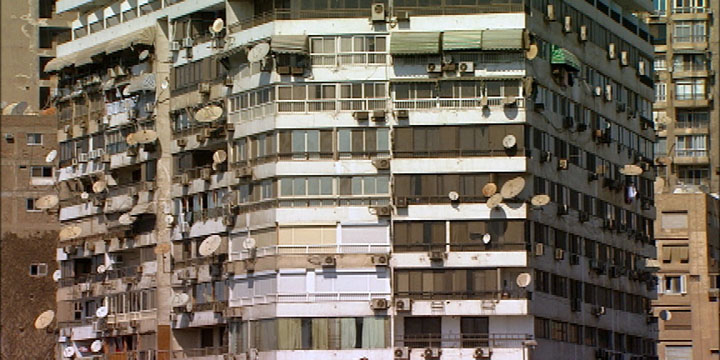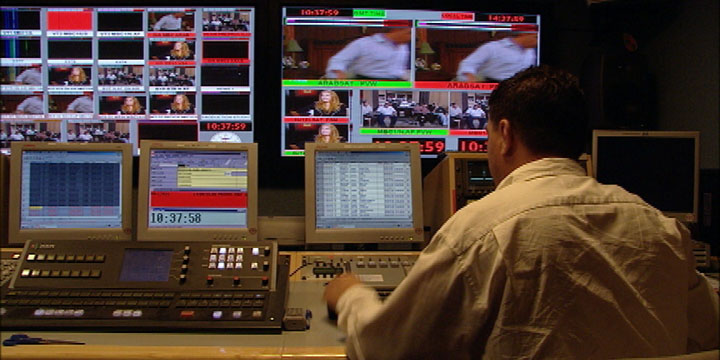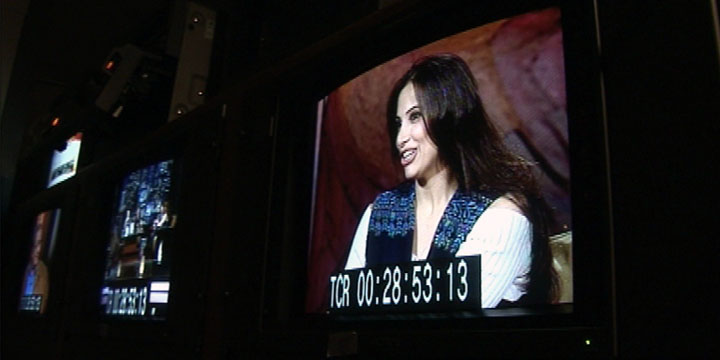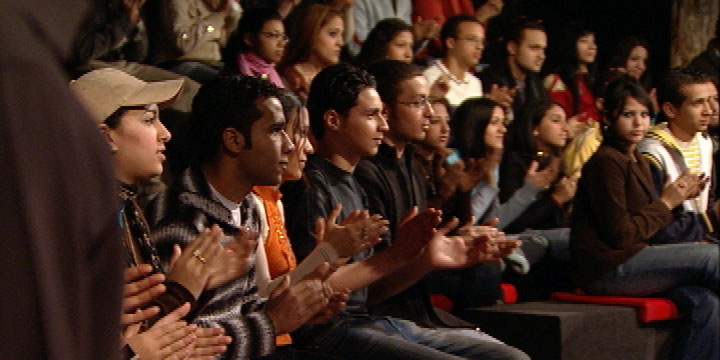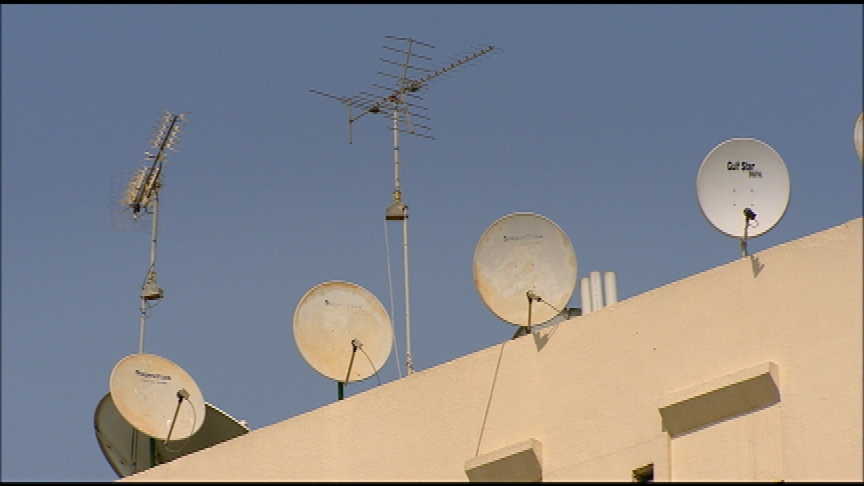The introduction of satellite television in the Middle East in the early 1990s completely transformed its media landscape. Satellite channels set in motion the emergence of modern TV journalism, live debate and reality TV. The number of satellite channels has tripled since 2004, and, today, the majority of households in the region have satellite TV.
The Handbook highlights the history of television programming, its funding and the role of women, democracy and the United States in the Arab satellite television revolution.
Part 1: HISTORY & PROGRAMMING
In the 1960s, the Arab television landscape consisted of terrestrial channels that broadcast a melee of government-controlled news, mostly localized to their country of origin, and covering official inaugurations, ceremonial events and reporting on the whereabouts of heads of states. This strict diet was diluted by an array of non-controversial entertainment programs, Arab films and locally produced soaps, as well as shows imported from abroad, broadcast in their post-censorship variations and largely adapted to local laws, customs, and traditions.
By the 1990s the Arab soil was ripe for a new crop. The government of Egypt was the first to launch an Arab satellite channel, initially relying on programming from the existing terrestrial channels. But the strongest catalyst for radical change in the Arab media landscape was CNN’s live coverage of the Gulf War in 1991. Until then, Arab audiences had virtually no access to international news coverage. Watching live reports from the fields, often broadcast in real time, jolted the viewers across the Middle East, exposing them to the modern face of TV journalism and leaving them longing for more. Regional states, as well as private entrepreneurs, quickly recognized the strategic power of shaping public opinion through images. The Arab satellite media revolution was on the verge of re-shaping the Arab TV forever.
In September 1991, prominent Saudi businessman Sheikh Walid al-Ibrahim founded the first privately owned station, the Middle East Broadcasting Center (MBC) – taking the lead in establishing what has become a hugely popular media empire modeled on the Western programming style and format. Initially broadcast out of London, the channel allowed Arab audiences to watch, for the first time, events unfolding in Arab countries and abroad through the eyes of Arab reporters, in Arabic.
In 1996, the Emir of Qatar funded the launch of Al Jazeera, the first 24-hour news service in the region. The new proliferation of satellite dishes throughout the Middle East gave Al Jazeera a chance at a quickly growing audience. Al Jazeera’s daring, unfiltered, interactive debates, which included phone-ins where audience members could join in the live discussion, enhanced its popularity early on. Live debate on shows like THE OPPOSITE DIRECTION opened what some have hailed as the first forum for freedom of expression in the Middle East. In the context of repressive state policies, a station that dared to openly embrace free discussion was a radical move.
While most Arab satellite stations are private and commercial enterprises, relying on advertising income, commercial appeal, and targeting a new generation of world-savvy Middle Eastern youth, some are controlled by political parties and governments and others are mouthpieces for religious groups. For example, Hamas and Hezbollah, both of whom are defined as terrorist organizations by the U.S. government, each have their own stations.
The number of satellite channels in the Arab world has nearly tripled in the last three years. Today there are more than 250 satellite TV channels. The vast majority of production is concentrated in four media hubs. Beirut, Lebanon, is home to over a dozen television networks, including the Lebanese Broadcasting Corporation, Future TV, and Hezbollah’s Al Manar TV. In Cairo, Egypt, once known as the Hollywood of the Arab world, television dramas, soap operas, and talk shows are among the most watched and distributed throughout the Middle East. But today satellite television networks in the Gulf are competing with Egypt’s reach. Al Jazeera, headquartered in Doha, Qatar, transformed the small Persian Gulf state into a major world player in the field of news and information and, Reuters, CNN, and MBC are headquartered in Dubai’s Media Free Zone, an ultra-modern center for uncensored media coverage in the region.
Arab satellite TV programming covers a lot of ground, targeting topics that are both entertaining and poignant to contemporary Arab audiences. Largely comprised of music videos, news, and reality shows, it also includes shopping, sports and religious programs. The top ten channels, which reach an estimated 90 percent of Arab homes, flaunt top-rated programs like SUPER STAR, STAR ACADEMY and WHO WANTS TO WIN A MILLION – all of which are modeled after similar shows on Western TV.
Media analysts agree that the effect of satellite TV in the Arab world over the last 15 years have been profound. As Habib Battah, managing editor of the Middle East Broadcast Journal, explains, the creation of new forums that cross regional boundaries has established a virtual on-air community, a sense of Pan-Arab unity.
PART 2: OWNERSHIP & OVERSIGHT
In the 1960s, the Arab television landscape consisted of terrestrial channels that broadcast a melee of government-controlled news, mostly localized to their country of origin, and covering official inaugurations, ceremonial events and reporting on the whereabouts of heads of states. This strict diet was diluted by an array of non-controversial entertainment programs, Arab films and locally produced soaps, as well as shows imported from abroad, broadcast in their post-censorship variations and largely adapted to local laws, customs, and traditions.
By the 1990s the Arab soil was ripe for a new crop. The government of Egypt was the first to launch an Arab satellite channel, initially relying on programming from the existing terrestrial channels. But the strongest catalyst for radical change in the Arab media landscape was CNN’s live coverage of the Gulf War in 1991. Until then, Arab audiences had virtually no access to international news coverage. Watching live reports from the fields, often broadcast in real time, jolted the viewers across the Middle East, exposing them to the modern face of TV journalism and leaving them longing for more. Regional states, as well as private entrepreneurs, quickly recognized the strategic power of shaping public opinion through images. The Arab satellite media revolution was on the verge of re-shaping the Arab TV forever.
In September 1991, prominent Saudi businessman Sheikh Walid al-Ibrahim founded the first privately owned station, the Middle East Broadcasting Center (MBC) – taking the lead in establishing what has become a hugely popular media empire modeled on the Western programming style and format. Initially broadcast out of London, the channel allowed Arab audiences to watch, for the first time, events unfolding in Arab countries and abroad through the eyes of Arab reporters, in Arabic.
In 1996, the Emir of Qatar funded the launch of Al Jazeera, the first 24-hour news service in the region. The new proliferation of satellite dishes throughout the Middle East gave Al Jazeera a chance at a quickly growing audience. Al Jazeera’s daring, unfiltered, interactive debates, which included phone-ins where audience members could join in the live discussion, enhanced its popularity early on. Live debate on shows like THE OPPOSITE DIRECTION opened what some have hailed as the first forum for freedom of expression in the Middle East. In the context of repressive state policies, a station that dared to openly embrace free discussion was a radical move.
While most Arab satellite stations are private and commercial enterprises, relying on advertising income, commercial appeal, and targeting a new generation of world-savvy Middle Eastern youth, some are controlled by political parties and governments and others are mouthpieces for religious groups. For example, Hamas and Hezbollah, both of whom are defined as terrorist organizations by the U.S. government, each have their own stations.
The number of satellite channels in the Arab world has nearly tripled in the last three years. Today there are more than 250 satellite TV channels. The vast majority of production is concentrated in four media hubs. Beirut, Lebanon, is home to over a dozen television networks, including the Lebanese Broadcasting Corporation, Future TV, and Hezbollah’s Al Manar TV. In Cairo, Egypt, once known as the Hollywood of the Arab world, television dramas, soap operas, and talk shows are among the most watched and distributed throughout the Middle East. But today satellite television networks in the Gulf are competing with Egypt’s reach. Al Jazeera, headquartered in Doha, Qatar, transformed the small Persian Gulf state into a major world player in the field of news and information and, Reuters, CNN, and MBC are headquartered in Dubai’s Media Free Zone, an ultra-modern center for uncensored media coverage in the region.
Arab satellite TV programming covers a lot of ground, targeting topics that are both entertaining and poignant to contemporary Arab audiences. Largely comprised of music videos, news, and reality shows, it also includes shopping, sports and religious programs. The top ten channels, which reach an estimated 90 percent of Arab homes, flaunt top-rated programs like SUPER STAR, STAR ACADEMY and WHO WANTS TO WIN A MILLION – all of which are modeled after similar shows on Western TV.
Media analysts agree that the effect of satellite TV in the Arab world over the last 15 years have been profound. As Habib Battah, managing editor of the Middle East Broadcast Journal, explains, the creation of new forums that cross regional boundaries has established a virtual on-air community, a sense of Pan-Arab unity.
PART 3: ROLE OF WOMEN
Satellite TV is creating new opportunities for women, allowing them to occupy positions they were unable to through conventional print media, according to the 2006 Arab Human Development Report. Today more than half of the presenters on Arab television are women and are at the forefront of conversations that push at the boundaries of conservative Muslim and Arab society.
Fearless female reporters like May Chidiac, host of With Audacity, a popular show in Lebanon, are risking their lives to cover unreported stories. In September 2005, she lost her leg and hand in a failed assassination attempt. The attempt on Chidiac’s life was one of a string of car bombings targeting outspoken critics of Syria’s involvement in Lebanese politics.
Sexologist Heba Kotb is also boldly pushing the boundaries of restrictive social norms. Her weekly show The Big Talk allows viewers to call in and ask for sex advice. In a region, where sex education does not exist, Kotb is shattering taboos in an effort to promote sexual health and strengthen marital relationships. While her views on homosexuality might seem regressive to a Western audience, Kotb is painted as a radical by Islamic extremists, who are outraged that she takes her sex advice directly from the text of the Koran.
Not only has satellite TV increased women’s on-camera presence in the Middle East, it has also enhanced the day-to-day lives of women across the Arab world. Since nearly half of Arab women are illiterate, television serves as a tool to close the socio-economic divide, reaching educated and uneducated women alike. And because of the accessibility of satellite TV, women in developing and rural areas are learning about pressing social, political and economic issues such as ones discussed by people like Chidiac and Kotb.
Despite these advancements, the deep-rooted patriarchal system in the Middle East continues to create social, economic, cultural and legal barriers to women’s equal participation in Arab media. Men continue to dominate positions of power and decision making, and women still struggle for editorial control. In June 2007, female journalists from all over the Arab world gathered at the Sixth Annual Conference of the Arab Women Media Center in Amman, Jordan, to discuss freedom of the press and gender equality within media. Palestinian reporter Amal Jumah Khamis raised her frustrations about the limitations imposed by a law regulating women’s work hours, “I am a feminist and I can’t work past 8 o’clock.” Other women spoke about being required to wear the veil; men receiving preferential assignments; being refused a passport to travel for work; being looked on as less desirable as a marriage partner; and receiving lower pay and being passed over for promotions.
PART 4: MEDIA & DEMOCRACY
In a region characterized by repressive, authoritarian regimes, satellite television’s ability to transcend national borders and government control makes it an important catalyst for democracy. Competition can increase adherence to better journalistic standards. Field reports inform public opinion, which is strenghthened by audience participation in on-air debates. Freedom of information can create an informed public, which can encourage transparent decision-making and ultimately act as a tool to hold government institutions accountable.
News programs build expectations and a heightened sense of urgency for democratic change by illuminating corruption, inequality, and restrictions of freedom. Footage of democratic elections in Iraq and the Palestinian Territories and President Hosni Mubarak’s inclusion of opposition parties in Egypt’s presidential elections are examples of events broadcast across borders that have the power to provoke disagreement and encourage debate.
Debate programs on news channels are fertile ground for difference of opinions. Al Jazeera, for example, provides a platform to voice opposition, and in doing so, sets the example for a democratic foundation to millions of Arabs worldwide. MORE THAN ONE DIRECTION, one of its many weekly talk shows, offers experts and guests a platform to debate a variety of opinions regarding politics, society and culture in the Arab world.
While ballots might traditionally be the way citizens exercise their influence in society, in the Middle East the ballot is surpassed by the remote control and the text message. Some of the most successful programs, across genres, are those that involve audience participation. Music competition programs like STAR ACADEMY and SUPER STAR ask viewers to send a text message indicating their favorite contestant. This global trend is revolutionizing societal norms and behavior. Voting in a TV show, let alone in an election, was a foreign concept to millions of Arabs just a decade ago.
BBC Arabic TV, which is scheduled to launch in October 2007, is hoping to capitalize on the success of this audience participation. It’s planning to introduce a new technology known as iPoint that will allow viewers to call into a TV show from their 3G mobile phones or Internet webcams and participate live on air.
PART 5: U.S. ROLE
The power and popularity of Arab satellite television programming has not gone unnoticed by the U.S. government. After 9/11, U.S. officials became more actively involved in the region’s growing satellite TV market, creating a station of its own, and producing entertaining Arabic-language programming for licensing to satellite and cable television networks throughout the Middle East.
Some critics, including Al-Jazeera, have accused the United States of making attempts to hinder pan-Arab news coverage. In turn, the U.S. has accused Al Jazeera correspondents of acting as Al Qaeda operatives. In 2001, U.S. missiles destroyed Al Jazeera’s station in Kabul and in 2003, U.S. missiles hit its station in Baghdad. While Al Jazeera has suggested that the bombing was intentional, the U.S. insists that the stations were not deliberately targeted.
When Al Jazeera launched its international English-language channel in November 2006, it was shunned by U.S. cable companies. Only one carrier – a small cable service in Vermont – picked up the channel for broadcast. Al Jazeera weathered harsh criticism by U.S. officials like former secretary of defense Donald Rumsfeld who called it a “terrorist network” after airing exclusive post 9/11 interviews with Osama bin Laden. Although not available in the U.S., Al Jazeera’s English-language television is available in 80 million households worldwide, including Europe, Asia, Australia and Israel.
The United States has also taken steps to ensure its message reaches the Arab world. In May 2007, the National Security Archive released a report obtained through the Freedom of Information Act that uncovered the Defense Department’s recommendation to create a Rapid Reaction Media Team in Iraq in 2003. This team was intended to help a liberated Iraqi media transition from state-controlled media outlets to a free press. The RRMT vision included a cadre of U.S.-trained Iraqi journalists who would broadcast programming based on “U.S. government policy guidance and oversight.”
In 2004, the U.S. government created its own Arab television station, Al Hurra, or The Free One, as part of the Bush administration strategy of promoting freedom in the Middle East. The station aims to portray a positive image of America in the region, countering what conservatives deem a negative portrayal of America by Arab broadcasters. With an annual budget of more than 70 million dollars, the station reports on regional and international events to 22 countries in the Arab region.
Al Hurra came under fire in December 2006 when it broadcast a speech by Hezbollah leader Hassan Nasrallah. Journalist Joel Mowbray of the WALL STREET JOURNAL wrote, “Our taxpayer-financed Arabic network was set up to counter Al-Jazeera, not echo it.” The editorial director received a series of scathing personal and professional public attacks and resigned from the station.
Critics argue that such incidents illustrate that Al Hurra is a government-controlled vehicle for spreading U.S. propaganda. Arab media analyst Marc Lynch writes that the resignation of the editorial director “likely seals the fate of Al Hurra, which looks ever more like Radio and TV Marti – the anti-Castro stations beloved by American conservatives and Cuban exiles, which maintain exorbitant budgets year after year even though hardly any Cubans ever tune in.” He says that the incident marks a failure in public diplomacy, but also demonstrates the difficulty in establishing a free and credible media outlet amidst Washington’s policy agenda in the Middle East.

